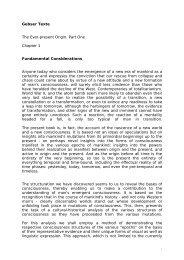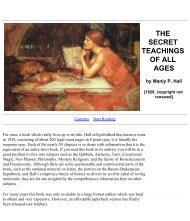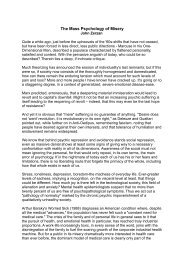Erik Satie and the Avant Garde - michaeljgoodnight.com
Erik Satie and the Avant Garde - michaeljgoodnight.com
Erik Satie and the Avant Garde - michaeljgoodnight.com
You also want an ePaper? Increase the reach of your titles
YUMPU automatically turns print PDFs into web optimized ePapers that Google loves.
http://www.jstor.org/stable/741803<br />
<br />
Your use of <strong>the</strong> JSTOR archive indicates your acceptance of JSTOR's Terms <strong>and</strong> Conditions of Use, available at<br />
http://www.jstor.org/page/info/about/policies/terms.jsp. JSTOR's Terms <strong>and</strong> Conditions of Use provides, in part, that unless<br />
you have obtained prior permission, you may not download an entire issue of a journal or multiple copies of articles, <strong>and</strong> you<br />
may use content in <strong>the</strong> JSTOR archive only for your personal, non-<strong>com</strong>mercial use.<br />
Please contact <strong>the</strong> publisher regarding any fur<strong>the</strong>r use of this work. Publisher contact information may be obtained at<br />
http://www.jstor.org/action/showPublisher?publisherCode=oup.<br />
Each copy of any part of a JSTOR transmission must contain <strong>the</strong> same copyright notice that appears on <strong>the</strong> screen or printed<br />
page of such transmission.<br />
JSTOR is a not-for-profit organization founded in 1995 to build trusted digital archives for scholarship. We work with <strong>the</strong><br />
scholarly <strong>com</strong>munity to preserve <strong>the</strong>ir work <strong>and</strong> <strong>the</strong> materials <strong>the</strong>y rely upon, <strong>and</strong> to build a <strong>com</strong>mon research platform that<br />
promotes <strong>the</strong> discovery <strong>and</strong> use of <strong>the</strong>se resources. For more information about JSTOR, please contact support@jstor.org.<br />
Oxford University Press is collaborating with JSTOR to digitize, preserve <strong>and</strong> extend access to The Musical<br />
Quarterly.<br />
http://www.jstor.org
<strong>Erik</strong> <strong>Satie</strong> <strong>and</strong> <strong>the</strong> Concept<br />
of <strong>the</strong> <strong>Avant</strong>-<strong>Garde</strong><br />
ALAN M. GILLMOR<br />
T is undeniable that <strong>Erik</strong> <strong>Satie</strong> possessed a creative imagination of a<br />
most distinctive kind <strong>and</strong> that <strong>the</strong> innovations <strong>and</strong> aes<strong>the</strong>tic attitudes<br />
of <strong>the</strong> ingenuous citizen of <strong>the</strong> grimy Parisian suburb of Arcueil-<br />
Cachan provided a stimulus for a great deal of contemporary artistic<br />
activity. By <strong>the</strong> st<strong>and</strong>ards of <strong>the</strong> great Austro-German tradition <strong>and</strong> its<br />
direct extensions, <strong>Satie</strong>, in his lifetime, had to be considered a <strong>com</strong>-<br />
poser of little consequence, <strong>and</strong> unfortunately <strong>the</strong> type of buffoonery<br />
with which his name is irrevocably associated has long militated<br />
against his general acceptance by critics, causing his achievement to<br />
remain at best misunderstood <strong>and</strong> at worst shrouded in obscurity. As<br />
Wilfrid Mellers has pointed out:<br />
Probably no o<strong>the</strong>r figure in modern music has been subjected to such persistently<br />
ignorant denigration as <strong>Erik</strong> <strong>Satie</strong>. Fear of responding to something which is genuinely<br />
new or disturbing to <strong>the</strong>ir <strong>com</strong>placency has led people with only <strong>the</strong> most<br />
superficial acquaintance with his work to dismiss <strong>Satie</strong> as an in<strong>com</strong>petent blagueur,<br />
an eccentric who wrote odd sentences over his music, whose <strong>com</strong>positions can be<br />
ignored with cheerful irresponsibility or at worst dismissed with some such epi<strong>the</strong>t as<br />
"thin."'<br />
Throughout his life <strong>Satie</strong> eventually rejected each group of young<br />
<strong>com</strong>posers which ga<strong>the</strong>red around him. Through this process he<br />
managed to remain continuously in <strong>the</strong> vanguard, <strong>and</strong> his frequent<br />
alliances with younger men explain, in part, his infantile <strong>and</strong> artless<br />
nature while pointing, perhaps, to a deep-rooted <strong>and</strong> lifelong insecurity.<br />
Writing in Jean Cocteau's ephemeral broadsheet, Le Coq, <strong>Satie</strong><br />
declared that a school of <strong>Satie</strong> did not exist <strong>and</strong> that it never would for<br />
1 "<strong>Erik</strong> <strong>Satie</strong> <strong>and</strong> <strong>the</strong> 'Problem' of Contemporary Music," Music <strong>and</strong> Letters, XXIII (1942),<br />
210. Parts of this article, including a slightly abridged version of <strong>the</strong> passage quoted, appeared in<br />
"The Classicism of <strong>Erik</strong> <strong>Satie</strong>," The Listener, XVIII (August 11, 1937), 318.<br />
104
<strong>Satie</strong> <strong>and</strong> <strong>the</strong> <strong>Avant</strong>-<strong>Garde</strong><br />
105<br />
"Sateism" was not possible. He added that if such a school were to<br />
appear, he would be opposed to it. <strong>Satie</strong> went on to note that submission<br />
in art was impossible. In each <strong>com</strong>position, he asserted, he tried<br />
to use <strong>the</strong> structure <strong>and</strong> content that would confuse his followers. In<br />
that way an artist could not be<strong>com</strong>e a pedant or a founder of a school.2<br />
Through his association with <strong>the</strong> latest trends in French music, <strong>Satie</strong>,<br />
until his death in 1925, was a seminal influence on a variety of<br />
vanguard movements, some ultimately important, o<strong>the</strong>rs decidedly<br />
removed from <strong>the</strong> mainstream of twentieth-century artistic evolution<br />
<strong>and</strong> consequently short-lived.<br />
After <strong>the</strong> first performance of Mercure at <strong>the</strong> Theatre de la Cigale<br />
on June 15, 1924, <strong>the</strong> poet <strong>and</strong> critic Rene Chalupt reported that <strong>the</strong><br />
ballet was poorly received, even by <strong>Satie</strong>'s best friends.3 Serge Leonidovich<br />
Grigoriev, who had served as Diaghilev's regisseur for twenty<br />
years <strong>and</strong> who in that time had witnessed many strange <strong>and</strong> wonderful<br />
things, felt that Mercure was, quite simply, "utterly nonsensical."4<br />
Apparently <strong>the</strong> critic for <strong>the</strong> London Observer was inclined to <strong>the</strong><br />
same view, for his droll description of <strong>the</strong> ballet's revival in Engl<strong>and</strong><br />
some three years later has captured something of <strong>the</strong> frivolous atmosphere<br />
of Picasso's decor, Massine's choreography, <strong>and</strong> <strong>Satie</strong>'s banal<br />
musical cliches:<br />
It began with a picture called "Night." This suggested an anthropomorphic<br />
powder-puff transfixed by hairpins to a square, but sparsely-curranted, bun. There<br />
followed a dolorous love-dance between Venus <strong>and</strong> Apollyon, as rigorous in pose as it<br />
was abortive; slow processions of Ugly-wugglies contrived from cardboard <strong>and</strong> exp<strong>and</strong>ing<br />
metal; "The Bath of <strong>the</strong> Graces," suggestive of life on a submerged houseboat<br />
as lived by three Edwardian barmaids with hypertrophied period busts; a sharp<br />
encounter with Cerberus, <strong>and</strong> o<strong>the</strong>r celestial <strong>and</strong> infernal pranks whose pagan character<br />
defies brief description.<br />
Through this series of plastic poses flew Mercury, a vivid figure in white tunic <strong>and</strong><br />
scarlet coat, enthusiastically danced by Massine. The whole was ac<strong>com</strong>panied by<br />
music to suit, dominated by a grumbling tuba.5<br />
2 Le Coq, No. 2 (June, 1920). Cocteau's broadsheet, founded on March 6, 1920, was<br />
destined to appear only four times: May, June, July/August/September, <strong>and</strong> November, 1920.<br />
Numbers 3 <strong>and</strong> 4 were called Le Coq parisien. All four issues, originally printed on large folded<br />
sheets of pink paper, are reprinted in smaller facsimile in a double issue of L'Approdo musicale,<br />
No. 19-20 (1965), dedicated to "II Gruppo dei Sei." <strong>Satie</strong>'s text has been reprinted in Ornella<br />
Volta, ed., <strong>Erik</strong> <strong>Satie</strong>: Ecrits (Paris, 1977), p. 45.<br />
3 "Paris Letter," The Chesterian, VI (October, 1924), 24.<br />
4 The Diaghilev Ballet, 1909-1929, trans. <strong>and</strong> ed. Vera Bowen (London, 1953), p. 238.<br />
5 H. H. [Horace Horsnell], "Mercury," The Observer (London), July 17, 1927, p. 15.
106<br />
The Musical Quarterly<br />
Five months after <strong>the</strong> opening of Mercure in Montmartre, Relache,<br />
<strong>Satie</strong>'s parting snub at <strong>the</strong> old world he entered (<strong>and</strong> left) very young,<br />
provoked an even greater storm of protest, reminiscent of <strong>the</strong> heady<br />
days of Parade. <strong>Satie</strong>'s erstwhile friend <strong>and</strong> disciple Rol<strong>and</strong>-Manuel,<br />
his classmate at <strong>the</strong> Schola Cantorum <strong>and</strong> orchestrator of several of his<br />
early works including <strong>the</strong> Prelude de la porte heroique du ciel <strong>and</strong> <strong>the</strong><br />
second Gymnopedie, ra<strong>the</strong>r maliciously entitled his review of Relache<br />
"Adieu a <strong>Satie</strong>," thus setting <strong>the</strong> tone for a flood of adverse criticism. In<br />
<strong>the</strong> opinion of Rol<strong>and</strong>-Manuel, <strong>the</strong> spirit of Dada had fed <strong>Satie</strong>'s<br />
incoercible appetite for sly buffoonery <strong>and</strong> had tragically undermined<br />
<strong>the</strong> graceful whimsy of <strong>the</strong> earlier piano works. The result was Relache,<br />
a vulgar work of unimaginable boredom <strong>and</strong> distressing<br />
silliness.6<br />
Perceptive readers of Le Journal litteraire six weeks before <strong>the</strong><br />
premiere of <strong>the</strong> ballet would have been better prepared for <strong>the</strong> fiasco at<br />
<strong>the</strong> Theatre des Champs-Elysees on December 4.7 In a rare interview,<br />
<strong>Satie</strong> outlined briefly <strong>the</strong> surrealistic scenario of Relache <strong>and</strong> explained<br />
that he intended <strong>the</strong> music to be lively <strong>and</strong> colorful, that he<br />
had in fact <strong>com</strong>posed, "for <strong>the</strong> 'chic set,' amusing <strong>and</strong> pornographic<br />
(sic) music."8 Additional bait, if any were needed, was provided by<br />
Francis Picabia in a mock interview with <strong>the</strong> director of <strong>the</strong> Swedish<br />
Ballet, who asked <strong>the</strong> painter to explain <strong>the</strong> scenario of <strong>the</strong> ballet in<br />
preparation for <strong>the</strong> opening performance a week away; Picabia's<br />
characteristically supercilious reply: "Rel&che? Music by <strong>Erik</strong> <strong>Satie</strong>...<br />
explain what to you my dear Rolf de Mare? Do you take me for<br />
Einstein?"9<br />
Forewarned or not, <strong>the</strong> Parisian press descended upon <strong>the</strong> <strong>com</strong>-<br />
6 Rol<strong>and</strong>-Manuel [Rol<strong>and</strong>-Alexis Manuel Levy], "Adieu a <strong>Satie</strong>," Revue pleyel, No. 15<br />
(December, 1924), 21-22.<br />
7 Relache lived up to its name, for <strong>the</strong>re is general confusion concerning <strong>the</strong> precise date of<br />
<strong>the</strong> premiere. Of <strong>the</strong> st<strong>and</strong>ard monographs on <strong>Satie</strong>, only Anne Rey, <strong>Erik</strong> <strong>Satie</strong> (Paris, 1974)<br />
provides <strong>the</strong> correct date: December 4, 1924. Scheduled to receive "Le Tout-Paris" on Thursday,<br />
November 27, <strong>the</strong> Theatre des Champs-Elysbes remained resolutely closed to <strong>the</strong> elegant crowd of<br />
anxious first-nighters, ostensibly owing to <strong>the</strong> indisposition of Jean B6rlin, leading male dancer<br />
with <strong>the</strong> Swedish Ballet. Two days later an announcement to that effect was seen in Comoedia,<br />
followed by a short explanatory note by Francis Poulenc entitled "Pourquoi Relaiche a fait<br />
rel5che," which appeared in <strong>the</strong> same newspaper on I)ecember 2, two days before <strong>the</strong> rescheduled<br />
opening.<br />
8 'Ihe ironical (sic) is in <strong>the</strong> original. W. Mayr, "Entretien avec <strong>Erik</strong> <strong>Satie</strong>," Le Journal<br />
litteraire, No. 24 (October 4, 1924), 11.<br />
9 Rolf de Mar&, "A propos de Relache," Comsoedia, November 27, 1924, p. 2.
<strong>Satie</strong> <strong>and</strong> <strong>the</strong> <strong>Avant</strong>-<strong>Garde</strong><br />
107<br />
poser <strong>and</strong> his Dada colleagues with a vengeance. All <strong>the</strong> major critics<br />
were in attendance-Andre Messager for Le Figaro, Henry Malherbe<br />
for Le Temps, Emile Vuillermoz for Excelsior, Jean G<strong>and</strong>rey-Rety for<br />
Comoedia, Robert Dezarnaux for La Liberte, Fern<strong>and</strong> Le Borne for Le<br />
Petit Parisien, Paul Dambly for Le Petit Journal, Rol<strong>and</strong>-Manuel for<br />
L'Eclair, even Louis Schneider representing <strong>the</strong> New York Herald.<br />
Although <strong>the</strong>re was considerable praise in some quarters for Rene<br />
Clair's pioneering film Entr'acte,'? <strong>Satie</strong>'s music suffered almost universal<br />
condemnation, <strong>the</strong> general opinion being that <strong>the</strong> score was so<br />
poor <strong>and</strong> simple-"raving proletarian music" according to one<br />
report"-that it was beneath criticism.<br />
Only months before his death it appeared that <strong>the</strong> godfa<strong>the</strong>r of Les<br />
Six <strong>and</strong> L'Ecole d'Arcueil was about to disappear beneath a mountain<br />
of negative publicity. Undoubtedly <strong>the</strong> public was wearying of <strong>the</strong><br />
juvenile stunts of <strong>the</strong> Dadaists. By 1924, <strong>the</strong> year which saw <strong>the</strong><br />
publication of Andre Breton's first Surrealist Manifesto, <strong>the</strong> force of<br />
Dadaism was nearly spent. It had begun to take itself seriously, had<br />
allowed itself to be<strong>com</strong>e dogmatically allied with organized revolutionary<br />
politics, <strong>and</strong> had thus transpired to rematerialize as Surrealism,<br />
an artistic movement strongly rooted in reaction to Dada's destructive<br />
anarchism <strong>and</strong> nihilistic spontaneity. <strong>Satie</strong>, on <strong>the</strong> strength<br />
of <strong>the</strong> sc<strong>and</strong>alous Parade <strong>and</strong> <strong>the</strong> even more outrageous Le Piege de<br />
Meduse, a Jarry-like prefiguration of Dada <strong>and</strong> <strong>the</strong> Theater of <strong>the</strong><br />
Absurd, was taken up by <strong>the</strong> Dadaists in <strong>the</strong> early 1920s as a kind of<br />
unofficial <strong>com</strong>poser to <strong>the</strong> group, <strong>and</strong> we can now see Relache as one<br />
of <strong>the</strong> movement's last <strong>and</strong> most glorious spasms.<br />
The "official" attitude toward <strong>the</strong> <strong>com</strong>poser of Mercure <strong>and</strong> Relache<br />
was perhaps best summarized by Georges Jean-Aubry in a scathing<br />
article which appeared several months before <strong>Satie</strong>'s death.12<br />
Again his last work was <strong>the</strong> chief cause of <strong>the</strong> reversal of opinion. Less<br />
than a decade earlier Jean-Aubry had paid homage to <strong>Satie</strong> in his<br />
Musique franfaise d'aujourd'hui (1916); <strong>and</strong>, in <strong>the</strong> same year, writing<br />
for an English journal in advance of a proposed <strong>Satie</strong> visit to Great<br />
10 See, for example, Robert Desnos, "Cinema: Entr'acte par Francis Picabia, mise en scene<br />
de Reni Clair," Le Journal litteraire, No. 34 (December 13, 1924), 15. Desnos does not hesitate to<br />
nominate Entr'acte as "le plus beau film de l'annee."<br />
11 Paul Dambly, "Premieres Ripresentations: Les Ballets suidois-Relache," Le Petit<br />
Journal, December 9, 1924, p. 4.<br />
12 "The End of a Legend," The Chesterian, VI (May, 1925), 191-93.
108<br />
The Musical Quarterly<br />
Britain,13 <strong>the</strong> French critic wrote of <strong>the</strong> "genuine musicality" of <strong>the</strong><br />
<strong>com</strong>poser, <strong>and</strong> concluded that "behind his apparent lack of respect for<br />
music, lurks a sincere love of it, such as one sometimes fails to find in<br />
<strong>the</strong> depths of <strong>the</strong> soul of certain master builders of works of large<br />
dimensions, for whom music is nothing more than scientific boredom.'14<br />
But exposure to <strong>the</strong> late ballets radically altered Jean-Aubry's<br />
view, <strong>and</strong>, after witnessing <strong>the</strong> sc<strong>and</strong>al of Relache, <strong>the</strong> disgruntled<br />
critic was <strong>com</strong>pelled to write:<br />
... Relache has at last opened <strong>the</strong> eyes, or ra<strong>the</strong>r <strong>the</strong> ears, of those who would nei<strong>the</strong>r<br />
see nor listen <strong>and</strong> who persisted in maintaining that <strong>Satie</strong> was a master. Disillusioned,<br />
<strong>and</strong> having decided to remain no longer among those of whom <strong>the</strong> proverb says,<br />
"none so deaf as those who will not hear," <strong>the</strong>y were forced to confess, while listening<br />
to Relache, that <strong>the</strong>y were, in fact, listening to nothing.'5<br />
Writing in <strong>the</strong> vituperative vein of one who has just discovered that<br />
he has been duped, Jean-Aubry went on to denounce Parade, <strong>and</strong> even<br />
Socrate-perhaps <strong>Satie</strong>'s chief claim to immortality-which he dismissed<br />
as a pretentious piece wherein poverty <strong>and</strong> boredom are in<br />
open conflict. His bitter conclusion is a judicious marriage of poetic<br />
imagery <strong>and</strong> invective tinged with regret, as he sees in <strong>the</strong> <strong>com</strong>poser<br />
"an old actor who, because he has once played <strong>the</strong> part of Napoleon<br />
<strong>and</strong> been applauded by provincials, imagines himself to be really <strong>the</strong><br />
great captain, but who, looking in a mirror, sees only an old man<br />
ab<strong>and</strong>oned in <strong>the</strong> melancholy twilight of a deserted cafe."'16<br />
Henry Pruniires, in his obituary for The Musical Digest, although<br />
kinder to <strong>Satie</strong> than Jean-Aubry, echoed his colleague's opinion by<br />
suggesting that <strong>Satie</strong>'s rediscovery in <strong>the</strong> postwar period, thrusting<br />
him abruptly into <strong>the</strong> limelight, was detrimental to his art. The<br />
<strong>com</strong>poser on several occasions experienced <strong>the</strong> frustration of seeing<br />
13 "<strong>Erik</strong> <strong>Satie</strong>: A Musical Humorist," The Music Student, IX (December, 1916), 135-36.<br />
The proposed visit to Great Britain, mentioned nowhere else in <strong>the</strong> <strong>Satie</strong> literature, never<br />
materialized. Jean-Aubry noted that <strong>Satie</strong> was to have appeared in performances of his own<br />
works at one of <strong>the</strong> War Emergency Concerts in Steinway Hall on December 7, 1916, <strong>and</strong> that<br />
from London he was to have traveled to Newcastle <strong>and</strong> Edinburgh. The Observer, December 10,<br />
1916, p. 15, reveals that <strong>the</strong> guest of honor in Steinway Hall on December 7 was in fact Florent<br />
Schmitt in a performance of his Piano Quintet, Op. 51, with <strong>the</strong> Belgian Quartet. In <strong>the</strong> next<br />
issue of The Music Student, IX (January, 1917), 163, Jean-Aubry solves <strong>the</strong> mystery by reporting<br />
that <strong>Satie</strong> found it impossible to take part in <strong>the</strong> performances arranged for him in <strong>the</strong> United<br />
Kingdom; <strong>the</strong>re is no evidence that such a trip was ever made at a later date.<br />
14 "<strong>Erik</strong> <strong>Satie</strong>: A Musical Humorist," 136.<br />
15 "The End of a Legend," 191.<br />
16 Ibid., 193.
<strong>Satie</strong> <strong>and</strong> <strong>the</strong> <strong>Avant</strong>-<strong>Garde</strong><br />
109<br />
his innovations taken up by younger more talented <strong>com</strong>posers who<br />
quickly outgrew <strong>the</strong>ir need of him. Consequently, Prunieres contends,<br />
he became jealous of <strong>the</strong> success of <strong>com</strong>posers whom he had<br />
supported, <strong>and</strong> his former modesty, dignity, <strong>and</strong> charm were gradually<br />
displaced by an intense bitterness <strong>and</strong> irascibility which barely<br />
managed to hide under <strong>the</strong> surface of an increasingly caustic wit. As<br />
Prunieres bluntly put it: "His success killed him."'7<br />
<strong>Satie</strong> had been dead only a fortnight when Eric Blom, in a harsh<br />
notice for <strong>the</strong> Musical News <strong>and</strong> Herald, wrote of France's "original<br />
but ineffectual musician" with <strong>the</strong> apparent intention of closing <strong>the</strong><br />
<strong>Satie</strong> case once <strong>and</strong> for all:<br />
Independent critics at no time cherished any illusion about <strong>the</strong> fertility of <strong>Satie</strong>'s<br />
work. He mildly amused <strong>the</strong>m once or twice by his humorous pieces <strong>and</strong> by <strong>the</strong><br />
<strong>the</strong> lesson of <strong>Satie</strong>. The years pass-<strong>and</strong> <strong>the</strong> misunderst<strong>and</strong>ings."19<br />
<strong>Satie</strong> opened <strong>and</strong> closed his career with a hoax, beginning in 1887<br />
with <strong>the</strong> appearance of his first published score facetiously labeled<br />
Opus 62 <strong>and</strong> ending in 1924 with <strong>the</strong> sc<strong>and</strong>al of Relache <strong>and</strong> his<br />
notorious appearance on stage in a five-horsepower Citroen automobile<br />
with a poster proclaiming <strong>Erik</strong> <strong>Satie</strong> "<strong>the</strong> greatest musician in <strong>the</strong><br />
17 "The Failure of Success," The Musical Digest, VIII (July 28, 1925), 5.<br />
18 "<strong>Erik</strong> <strong>Satie</strong> (1866-1925)," Musical News <strong>and</strong> Herald, LXIX (July 18, 1925), 53.<br />
19 "<strong>Erik</strong> <strong>Satie</strong>," Les Nouzelles litteraires, July 11, 1925, p. 1.<br />
pa<strong>the</strong>tically <strong>com</strong>ic false position into which he had been thrust by a few of <strong>the</strong> people<br />
who are ever eager for innovation, whatever its quality may be. But his last few years<br />
deserved unalloyed pity. One was sorry for him as for a preposterous eccentric who has<br />
been robbed of his belief in <strong>the</strong> reality of his attitudes, whom life has left high <strong>and</strong> dry<br />
on an arid s<strong>and</strong>bank once mistaken by him for a fruitful isl<strong>and</strong>. It was said of <strong>Satie</strong> by<br />
some manipulator of clichs that he was born before his time; all one can say now,<br />
with <strong>the</strong> sorrowful indulgence one owes to <strong>the</strong> departed, is that he unhappily died too<br />
late to leave a world of unwholesome flattery without bitterness.18<br />
Thus many of <strong>Satie</strong>'s cronies, perhaps under some pressure from <strong>the</strong><br />
critics, began to desert him <strong>and</strong> his ideals, some, like Rol<strong>and</strong>-Manuel,<br />
with considerable fanfare, <strong>the</strong> greater number silently, although those<br />
closest to him-Milhaud, Sauguet, Desormiere, Caby, Wienerremained<br />
faithful to <strong>the</strong> end. Significantly, despite his periodic difficulties<br />
with <strong>the</strong> implacable <strong>and</strong> extraordinarily sensitive <strong>com</strong>poser,<br />
Georges Auric, youngest of Les Six <strong>and</strong> one of <strong>Satie</strong>'s first disciples,<br />
was genuinely moved by his death, <strong>and</strong> he had <strong>the</strong> courage to conclude<br />
his front-page obituary for Les Nouvelles litteraires with a simple,<br />
touching, <strong>and</strong> prophetic statement: "I will never regret having heeded
110<br />
The Musical Quarterly<br />
world." Thus <strong>the</strong>re is a remarkable consistency in <strong>Satie</strong>'s actions<br />
which suggests that it is futile to attempt an explanation of his<br />
behavior in terms of a series of traumas which sent him spinning into<br />
<strong>the</strong> role of <strong>the</strong> outsider. His posture was in <strong>the</strong> nature of <strong>the</strong> man <strong>and</strong><br />
his time, <strong>and</strong> when <strong>the</strong> careers of his equally bizarre colleagues <strong>and</strong><br />
contemporaries-Eugene Vachette, Josephin Peladan, Alphonse Allais,<br />
Alfred Jarry-have been examined, <strong>Satie</strong>'s very uniqueness <strong>com</strong>es<br />
into question. Although he contrived to live two separate careers, one<br />
in <strong>the</strong> nineteenth, <strong>the</strong> o<strong>the</strong>r in <strong>the</strong> twentieth century, <strong>the</strong>re was no<br />
violent break in his stylistic development, no fundamental change of<br />
direction. His ideals were manifested early <strong>and</strong> he served <strong>the</strong>m<br />
throughout his entire career with undeviating loyalty.<br />
<strong>Satie</strong>'s early achievement appears quite remarkable in view of <strong>the</strong><br />
social <strong>and</strong> cultural milieu of <strong>the</strong> early years of <strong>the</strong> Third Republic.<br />
The Franco-Prussian War had left a prostrate France in a state of<br />
artistic, as well as political, confusion; <strong>the</strong> protracted hegemony of<br />
German music uneasily joined forces with a renewed French nationalism<br />
to produce a kind of aes<strong>the</strong>tic <strong>and</strong> cultural schizophrenia which<br />
was clearly exemplified by two events: <strong>the</strong> founding of <strong>the</strong> Societe<br />
Nationale de Musique in 1871 <strong>and</strong> <strong>the</strong> publication from 1885 to 1888<br />
of <strong>the</strong> Revue wagnerienne. <strong>Satie</strong>'s importance to <strong>the</strong> early development<br />
of modern French music is due in large part to <strong>the</strong> fact that he<br />
was demonstrably <strong>the</strong> first French musician of his generation to reject<br />
<strong>com</strong>pletely <strong>the</strong> regnant German style <strong>and</strong> <strong>the</strong> powerful Wagnerian<br />
stimulus. Most of <strong>the</strong> notable French <strong>com</strong>posers of <strong>the</strong> fin de siecle-<br />
Lalo, Massenet, Delibes, Chabrier, D'Indy-simply gallicized <strong>the</strong><br />
Wagnerian language <strong>the</strong>n sweeping much of Europe, or continued<br />
earlier French Romantic traditions in <strong>the</strong> form of lyric opera.<br />
Despite <strong>the</strong> eclecticism of much French music of <strong>the</strong> 1880s, when le<br />
culte wagnerien was at <strong>the</strong> peak of its influence, <strong>the</strong> musical avantgarde<br />
saw its tentative origins at this time. In <strong>the</strong> sister arts, progressive<br />
trends multiplied so quickly in <strong>the</strong> decades following <strong>the</strong> debacle of<br />
1871 that a historian of <strong>the</strong> period was prompted to say that "<strong>the</strong><br />
twentieth century could not wait fifteen years for a round number; it<br />
was born, yelling, in 1885."20<br />
The savage reaction to <strong>the</strong> Paris Commune in 1871 provides some<br />
evidence that France remained politically conservative under <strong>the</strong> new<br />
20 Roger Shattuck, The Banquet Years: The Origin of <strong>the</strong> <strong>Avant</strong>-<strong>Garde</strong> in France 1885 to<br />
World War I, revised edition (New York, 1968), p. 4.
<strong>Satie</strong> <strong>and</strong> <strong>the</strong> <strong>Avant</strong>-<strong>Garde</strong><br />
111<br />
Republic, as it had been under <strong>the</strong> Monarchy <strong>and</strong> <strong>the</strong> Empire. But <strong>the</strong><br />
artistic revolt against <strong>the</strong> philistinism <strong>and</strong> <strong>the</strong> solid bourgeois values<br />
of French society had begun long before 1870, with <strong>the</strong> cultivation of<br />
l'art pour l'art in <strong>the</strong> early part of <strong>the</strong> century. Thus 1870 can be<br />
considered a decisive date in French cultural history only in <strong>the</strong> sense<br />
that <strong>the</strong> disaster of <strong>the</strong> war had inflicted a psychological shock on<br />
France which ultimately became <strong>the</strong> catalyst for <strong>the</strong> splendid artistic<br />
achievements of la belle epoque <strong>and</strong> <strong>the</strong> early twentieth century.<br />
The disaster of <strong>the</strong> Prussian War had served to regenerate <strong>the</strong><br />
artistic spirit of France; but Ars gallica was to run head on into<br />
Wagner, that "great master of intellectual eroticism," as Philippe<br />
Jullian so aptly described him.21 It is one of <strong>the</strong> supreme ironies of<br />
French music history that <strong>the</strong> toxic Wagnerian virus should have<br />
infected France precisely at <strong>the</strong> moment when young French musicians<br />
were declaiming <strong>the</strong> virtues of Ars gallica. It is paradoxical, too,<br />
that with few exceptions, <strong>the</strong> charter members of <strong>the</strong> Societe Nationale<br />
de Musique spent varying periods of <strong>the</strong>ir careers grappling with <strong>the</strong><br />
specter of Wagner. All of <strong>the</strong> important French <strong>com</strong>posers of <strong>the</strong> last<br />
decades of <strong>the</strong> nineteenth century made <strong>the</strong> obligatory pilgrimage to<br />
Bayreuth. Saint-Sains was <strong>the</strong>re for <strong>the</strong> opening in 1876; Chausson<br />
<strong>and</strong> D'Indy went in 1882 for Parsifal; even <strong>the</strong> quintessentially French<br />
Faure made <strong>the</strong> journey in 1883, followed by Debussy in 1888 <strong>and</strong><br />
again in 1889, <strong>and</strong> Chabrier <strong>and</strong> Lekeu, also in 1889.<br />
After <strong>the</strong> demise of <strong>the</strong> Revue wagnerienne in 1888, <strong>the</strong> Wagnerian<br />
gospel was spread in France by a variety of journals such as La Revue<br />
independante, La Revue contemporaine, Le Saint-Graal, La Plume,<br />
La Revue blanche, <strong>and</strong> many o<strong>the</strong>rs, some ephemeral, o<strong>the</strong>rs lasting<br />
well into <strong>the</strong> twentieth century. Alfred Ernst, from 1891 to 1895 <strong>the</strong><br />
music critic of <strong>the</strong> influential Revue blanche-a journal for which<br />
Debussy became a critic in 1901-devoted nearly every one of his<br />
columns to a discussion of Wagner, as if no o<strong>the</strong>r musical activity were<br />
taking place in <strong>the</strong> Paris of <strong>the</strong> 1890s. In <strong>the</strong> words of <strong>the</strong> critic <strong>and</strong><br />
novelist Romain Roll<strong>and</strong>, "The whole universe was seen <strong>and</strong> judged<br />
by <strong>the</strong> thought of Bayreuth."22<br />
A fur<strong>the</strong>r blow to <strong>the</strong> cause of Ars gallica was dealt by Charles<br />
Lamoureux, a violinist-conductor who founded <strong>the</strong> Societe des Nou-<br />
21 Dreamers of Decadence: Symbolist Painters of <strong>the</strong> 1890s, trans. Robert Baldick (New<br />
York, 1971), p. 66.<br />
22 Musicians of To-Day, trans. Mary Blaiklock, reprint of 1915 edition (Freeport, N.Y.,<br />
1969), p. 253.
112<br />
The Musical Quarterly<br />
veaux Concerts on October 21, 1881, <strong>and</strong> who for eleven years presented<br />
his Concerts-Lamoureux at <strong>the</strong> Cirque des Champs-Elysees.<br />
Although he did present a wide variety of music, including that of<br />
young French <strong>com</strong>posers, his overriding passion was Wagner, <strong>and</strong><br />
more so than any o<strong>the</strong>r individual Lamoureux was responsible for<br />
forcing Wagner on Paris. The literati, however, needed no persuading.<br />
The fanaticism with which <strong>the</strong> Parisian intelligentsia worshipped<br />
Wagner is apparent from Frederick Brown's numinous description<br />
of a Lamoureux concert:<br />
Charles Lamoureux conducted Wagner's operas every Sunday during <strong>the</strong> summer in<br />
<strong>the</strong> Cirque d'ete, like a priest conducting mass. When he mounted <strong>the</strong> podium, his<br />
audience turned its eyes inward <strong>and</strong> observed a sacerdotal trance till <strong>the</strong> last note<br />
sounded. Even Mallarme, <strong>and</strong> for that matter all <strong>the</strong> symbolists, attended <strong>the</strong>se<br />
dominical rites.23<br />
Although Wagner's influence on French music was felt well into<br />
<strong>the</strong> first decades of <strong>the</strong> twentieth century, by 1890, <strong>the</strong> year of Cesar<br />
Franck's death, <strong>the</strong>re were signs of a revolt, a movement away from <strong>the</strong><br />
ubiquitous Wagnerian vogue. Two organizations were founded in <strong>the</strong><br />
1890s with <strong>the</strong> express purpose of studying <strong>and</strong> performing <strong>the</strong> masterpieces<br />
of <strong>the</strong> past. In 1892 Charles Bordes, a pupil of Franck <strong>and</strong><br />
organist of <strong>the</strong> church of St. Gervais, created <strong>the</strong> Chanteurs de Saint-<br />
Gervais for <strong>the</strong> performance of old polyphonic music <strong>and</strong> Gregorian<br />
chant. In addition to editing <strong>and</strong> publishing old church music, Bordes<br />
pioneered in <strong>the</strong> investigation <strong>and</strong> publication of French folk music,<br />
some of which he used as a basis for his own <strong>com</strong>positions. In 1894<br />
Bordes, along with D'Indy <strong>and</strong> <strong>the</strong> organist Felix Guilmant, founded<br />
<strong>the</strong> Schola Cantorum with <strong>the</strong> intention of reviving interest in <strong>the</strong><br />
music of <strong>the</strong> past, perpetuating <strong>the</strong> teaching of Franck, <strong>and</strong> encouraging<br />
contemporary <strong>com</strong>position. The Schola, under <strong>the</strong> direction of<br />
<strong>the</strong> reactionary D'Indy, was instrumental in aiding <strong>the</strong> restoration of<br />
Gregorian chant, work which was begun in <strong>the</strong> 1850s <strong>and</strong> 1860s by <strong>the</strong><br />
Benedictine monks of Solesmes. In January 1895, <strong>the</strong> Tribune de<br />
Saint-Gervais, <strong>the</strong> monthly Bulletin of <strong>the</strong> Schola Cantorum, began<br />
publication, <strong>and</strong> by 1908, <strong>the</strong> year in which <strong>Satie</strong> was graduated from<br />
<strong>the</strong> institution, <strong>the</strong> Schola had 320 pupils <strong>and</strong> was a strong rival of<br />
<strong>the</strong> Conservatoire as a training ground for <strong>com</strong>posers. In spite of all<br />
this native activity, it was to take ano<strong>the</strong>r Franco-German war to<br />
destroy <strong>the</strong> last vestiges of Wagnerism in France. In 1918 <strong>Satie</strong> could<br />
23 An Impersonation of Angels: A Biography of Jean Cocteau (New York, 1968), p. 8.
<strong>Satie</strong> <strong>and</strong> <strong>the</strong> <strong>Avant</strong>-<strong>Garde</strong><br />
113<br />
sarcastically question <strong>the</strong> patriotism of Frenchmen who did not love<br />
Wagner, pointing out in his deliciously cryptic manner that Wagner<br />
was, after all, a Frenchman who, by some geographical accident,<br />
happened to be born in Leipzig.24<br />
With <strong>the</strong> development of <strong>the</strong> l'art pour l'art aes<strong>the</strong>tic in <strong>the</strong> Romantic<br />
period, music had <strong>com</strong>e to be considered by many-Schopenhauer,<br />
for example-as <strong>the</strong> very pinnacle of <strong>the</strong> arts, <strong>and</strong> <strong>the</strong> creation<br />
of music a sacred calling. In its most elaborate form, <strong>the</strong> doctrine of<br />
art-for-art's sake divorced art entirely from a social context. Art was to<br />
be free from utilitarian st<strong>and</strong>ards <strong>and</strong> <strong>the</strong> artist absolved from all laws<br />
beyond those imposed by <strong>the</strong> form of art itself. The devotees of<br />
art-for-art's sake withdrew as much as possible from <strong>the</strong> world around<br />
<strong>the</strong>m <strong>and</strong> attempted to make art <strong>the</strong> sole center of <strong>the</strong>ir universe. It<br />
follows from such an attitude that <strong>the</strong> partisans of l'art pour l'art felt it<br />
<strong>the</strong>ir duty to practice a pervasive cynicism. In <strong>the</strong> words of Albert<br />
Guerard:<br />
The passion smouldering beneath <strong>the</strong> hard <strong>and</strong> polished surface was <strong>the</strong> hatred of<br />
successful mediocrity, Philistinism. The deluded populace could be ignored: <strong>the</strong><br />
enemy with whom <strong>the</strong>re could be no truce was <strong>the</strong> middle class, with its undeniable<br />
cunning, its control of worldly goods, its capacity for aping <strong>the</strong> externals of culture.<br />
Thus it was that Art for Art's Sake assumed a non-moral, even anti-moral attitude, for<br />
morality was <strong>the</strong> citadel of <strong>the</strong> Bourgeoisie.25<br />
Deriving from post-Kantian German idealism <strong>and</strong> imported to France<br />
in <strong>the</strong> early nineteenth century under several guises by various French<br />
litterateurs,26 <strong>the</strong> cult of art-for-art's sake from its inception fostered an<br />
artistic <strong>and</strong> spiritual elite, a select group of sensitive individuals who<br />
withdrew from what <strong>the</strong>y considered <strong>the</strong> stifling <strong>and</strong> deadening influence<br />
of bourgeois banality. For <strong>the</strong> disciples of art-for-art's sake,<br />
artistic creation <strong>and</strong> contemplation of <strong>the</strong> beautiful were <strong>the</strong> highest<br />
<strong>and</strong> noblest ends of life.<br />
It is hardly to be wondered that a generation imbued with such<br />
lofty aes<strong>the</strong>tic ideals, a generation still under <strong>the</strong> powerful influence of<br />
Wagnerism <strong>and</strong> all it represented to <strong>the</strong> artistic <strong>com</strong>munity, should<br />
react to a <strong>com</strong>poser of <strong>Satie</strong>'s stripe with bewilderment <strong>and</strong> an uneasy<br />
24 "Cahiers d'un mammifire (extraits)," L'Esprit nouveau, No. 7 (April, 1921), 833; reprinted<br />
in Volta, <strong>Erik</strong> <strong>Satie</strong>: Ecrits, p. 28; <strong>and</strong> idem, <strong>Erik</strong> <strong>Satie</strong> (Paris, 1979), p. 103; <strong>and</strong> in English<br />
translation, in Wilkins, The Writings of <strong>Erik</strong> <strong>Satie</strong>, p. 68.<br />
25 Art for Art's Sake (Boston <strong>and</strong> New York, 1936), p. 61.<br />
26 See John Wilcox, "The Beginnings of L'Art Pour L'Art," Journal of Aes<strong>the</strong>tics <strong>and</strong> Art<br />
Criticism, XI (1953), 360-77.
114<br />
The Musical Quarterly<br />
mixture of stupefaction <strong>and</strong> hostility. To such critics, <strong>the</strong> inheritors of<br />
The Great Tradition, <strong>the</strong> irreverent, clownish posture of a <strong>Satie</strong> was<br />
bound to be ana<strong>the</strong>ma, <strong>and</strong> if a few of <strong>the</strong>m happened to be sympa<strong>the</strong>tic<br />
toward him, <strong>the</strong>y were forced inevitably into <strong>the</strong> role of apologist.<br />
In <strong>the</strong> context of <strong>the</strong> prevailing ideology of high culture, critics<br />
have had no choice but to consider <strong>the</strong> jester from Arcueil a "problem,"<br />
a "strange case," <strong>and</strong> a "fascinating enigma."27 Thus <strong>the</strong> <strong>Satie</strong><br />
legend grew, <strong>and</strong> continues to grow, <strong>and</strong> <strong>the</strong> <strong>com</strong>poser remains a<br />
source of puzzlement <strong>and</strong> exasperation for those who are utterly<br />
encapsulated by <strong>the</strong> gods of haute culture.<br />
It is arguable that <strong>Satie</strong> was <strong>the</strong> first <strong>com</strong>poser to realize fully<br />
avant-garde ideals, <strong>and</strong>, at a time when avant-gardism, like anarchism,<br />
remained on <strong>the</strong> fringe, <strong>the</strong>re was no course open to critics but<br />
to see him as a freak, a dangerous influence, or a nonentity. <strong>Avant</strong>gardism<br />
is inextricably linked to <strong>the</strong> concept of art-for-art's sake. Its<br />
aes<strong>the</strong>tic basis is traceable to certain libertarian political movements<br />
of <strong>the</strong> early Romantic period-most notably anarchism in its various<br />
forms-<strong>and</strong> <strong>the</strong> sociological factors which gave momentum to <strong>the</strong><br />
realization of art-for-art's sake are to a great extent those which contributed<br />
to <strong>the</strong> formation of avant-garde ideals in <strong>the</strong> fin de siecle.<br />
Indeed, avant-gardism might be considered <strong>the</strong> inevitable consequence<br />
of <strong>the</strong> art-for-art's sake ideal, in its most virulent form its<br />
reductio ad absurdum.<br />
In his impressive study of The Theory of <strong>the</strong> <strong>Avant</strong>-<strong>Garde</strong>,28<br />
Renato Poggioli isolates several concepts as being central to a <strong>the</strong>ory<br />
of avant-gardism, chief among <strong>the</strong>m activism, antagonism, nihilism,<br />
<strong>and</strong> agonism. Poggioli defines activism as agitation "for no o<strong>the</strong>r end<br />
than its own self, out of sheer joy of dynamism, a taste for action, a<br />
sportive enthusiasm, <strong>and</strong> <strong>the</strong> emotional fascination of adventure."29<br />
He demonstrates that this activism is usually motivated by a reaction<br />
against someone or something, <strong>and</strong> this spirit of outward hostility he<br />
calls antagonism. A third characteristic of <strong>the</strong> avant-garde, nihilism, is<br />
defined as "joy ... in <strong>the</strong> inebriation of movement, . . . <strong>the</strong> act of<br />
beating down barriers, razing obstacles, destroying whatever st<strong>and</strong>s in<br />
27 See, for example, W. Wright Roberts, "The Problem of <strong>Satie</strong>," Music <strong>and</strong> Letters, IV<br />
(1923), 313-20; Rollo H. Myers, "The Strange Case of <strong>Erik</strong> <strong>Satie</strong>," The Musical Times, LXXXVI<br />
(1945), 201-3; <strong>and</strong> Everett Helm, "<strong>Satie</strong>-Still a Fascinating Enigma," Musical America, LXX-<br />
VIII (February, 1958), 27-28, 166.<br />
28 Trans. Gerald Fitzgerald (Cambridge, Mass., 1968).<br />
29 Ibid., p. 25.
<strong>Satie</strong> <strong>and</strong> <strong>the</strong> <strong>Avant</strong>-<strong>Garde</strong><br />
115<br />
its way."30 And finally, agonzsm results when <strong>the</strong> movement reaches<br />
<strong>the</strong> point of apocalypse, "where it no longer heeds <strong>the</strong> ruins <strong>and</strong> losses<br />
of o<strong>the</strong>rs <strong>and</strong> ignores even its own catastrophe <strong>and</strong> perdition."31 These<br />
principal governing concepts of <strong>the</strong> avant-garde reveal <strong>the</strong> presence of<br />
a strong destructive impulse, which seems implicit in <strong>the</strong> doctrine,<br />
<strong>and</strong> a belief in renewal <strong>and</strong> apocalypse through revolution.<br />
The external manifestations of avant-gardistic activism, antagonism,<br />
nihilism, <strong>and</strong> agonism are many <strong>and</strong> varied. The avant-garde<br />
artist's antagonism toward his public results in nonconformism, eccentricity,<br />
<strong>and</strong> exhibitionism. In its extreme form <strong>the</strong> avant-garde<br />
transcends mere scorn of <strong>the</strong> audience by questioning its very right to<br />
exist. As a result of <strong>the</strong>se attitudes, pronounced experimentalism<br />
be<strong>com</strong>es a norm of avant-garde art, <strong>and</strong> external formlessness, obscurity,<br />
inaccessibility, <strong>and</strong> a preoccupation with sensation are sought for<br />
<strong>the</strong>ir own sakes. There emerges with <strong>the</strong> avant-garde a tendency to<br />
explore art forms to <strong>the</strong>ir inner <strong>and</strong> outer limits, <strong>and</strong> ultimately <strong>the</strong>re<br />
are to be no limits. When <strong>the</strong> exploratory drive is directed toward<br />
expansion of <strong>the</strong> inner limits of art, <strong>the</strong> result is a marked interest in<br />
<strong>the</strong> world of <strong>the</strong> unconscious, in dreams, <strong>the</strong> stream of consciousness,<br />
<strong>and</strong> <strong>the</strong> irrational, characteristics of such modern art movements as<br />
Surrealism <strong>and</strong> Dadaism. Conversely, <strong>the</strong> expansion of <strong>the</strong> outer<br />
limits of art ultimately leads to such nihilistic avant-garde practices as<br />
action painting, self-destructing sculpture, r<strong>and</strong>om verse, <strong>and</strong> <strong>the</strong><br />
happening. Moreover, <strong>the</strong> antitraditional attitude of <strong>the</strong> avant-garde,<br />
its extreme rejection of <strong>the</strong> past, <strong>and</strong> its constant search for renewal<br />
explain in large part <strong>the</strong> cult's excessive exaltation of youth, its<br />
infantilism, <strong>and</strong> <strong>the</strong> con<strong>com</strong>itant development of <strong>the</strong> concept of art as<br />
play.<br />
It has been well documented by Marxist aes<strong>the</strong>ticians that <strong>the</strong><br />
rapid industrialization <strong>and</strong> increased urbanization of nineteenthcentury<br />
society produced a sense of spiritual dis<strong>com</strong>fort in <strong>the</strong> artist,<br />
out of which grew a feeling of instability <strong>and</strong> isolation-a sociopolitical<br />
condition which has been called alienation. The artist, believing<br />
himself estranged from <strong>the</strong> mass culture of a bourgeois, industrialized<br />
society, responds by cultivating his own norms, <strong>the</strong>reby<br />
making a virtue of his seclusion from <strong>the</strong> mass. As a consequence, his<br />
audience, feeling itself insulted, threatened, or even disregarded, re-<br />
30 Ibid., p. 26.<br />
31 Ibid.
116<br />
The Musical Quarterly<br />
sponds by ridiculing <strong>the</strong> artist <strong>and</strong> charging him with willful in<strong>com</strong>prehensibility.<br />
Poggioli sees this mutual antagonism as a primary<br />
cause of <strong>the</strong> avant-garde's penchant for grotesquerie, caricature, <strong>and</strong><br />
parody:<br />
Sometimes <strong>the</strong> artist ends up by considering <strong>the</strong> state of alienation as a disgraceful<br />
condemnation, a moral ghetto, <strong>and</strong> seeking to react against that oppressive feeling<br />
finds no way out but <strong>the</strong> grotesque one of self-caricature <strong>and</strong> self-mockery. Conscious<br />
of <strong>the</strong> fact that bourgeois society considers him nothing but a charlatan, he voluntarily<br />
<strong>and</strong> ostentatiously assumes <strong>the</strong> role of <strong>com</strong>ic actor.32<br />
In <strong>the</strong> period following World War I, especially in France, <strong>the</strong> cult of<br />
<strong>the</strong> bizarre <strong>and</strong> <strong>the</strong> nonsensical, of parody <strong>and</strong> caricature, reached<br />
almost epidemic proportions.<br />
In <strong>the</strong> last analysis, it would seem evident that <strong>the</strong> avant-garde,<br />
essentially a nihilist philosophy, is distinguished by a decided iconoclasm,<br />
an inclination toward <strong>the</strong> irrational <strong>and</strong> <strong>the</strong> farcical, a penchant<br />
for obscurity <strong>and</strong> hermeticism, <strong>and</strong> a general tendency toward<br />
abstraction <strong>and</strong> dehumanization.<br />
Even a summary correlation of Poggioli's <strong>the</strong>ories with <strong>the</strong> external<br />
events of <strong>Satie</strong>'s career reveals <strong>the</strong> uncanny accuracy with which<br />
<strong>the</strong> French <strong>com</strong>poser's artistic life mirrors <strong>the</strong> avant-garde ideal.<br />
Without belaboring <strong>the</strong> point, one can state categorically that none of<br />
his musical contemporaries so self-consciously practiced avantgardism,<br />
<strong>and</strong> few so carefully arranged artistic suicide, as did le bon<br />
maitre d'Arcueil. On several occasions after his "rediscovery" at <strong>the</strong><br />
h<strong>and</strong>s of Debussy <strong>and</strong> Ravel after 1910, <strong>the</strong> way was open to <strong>Satie</strong> to<br />
withdraw from <strong>the</strong> fray, had he been willing to accept <strong>the</strong> role of<br />
leader, prophet, indeed, pundit. But <strong>the</strong> idea of be<strong>com</strong>ing even a petit<br />
maitre was alien to <strong>the</strong> <strong>Satie</strong> aes<strong>the</strong>tic, even though <strong>the</strong> rejection of<br />
such a role meant his own certain destruction. Therefore <strong>the</strong> sincerity<br />
with which he sought official recognition at several stages of his<br />
career-notably his three notoriously unsuccessful attempts to gain<br />
admittance to <strong>the</strong> Institut de France in <strong>the</strong> 1890s-has to be questioned.<br />
Had fate, in all its quirkiness, provided <strong>Satie</strong> with official<br />
approbation when he first stormed <strong>the</strong> redoubtable academies, he most<br />
surely would have rejected it.<br />
<strong>Satie</strong> was a born iconoclast. It is evident that from his earliest years<br />
he was incapable of (<strong>and</strong> probably uninterested in) mastering <strong>the</strong><br />
traditional forms of musical expression. As a consequence he created<br />
32 Ibid., p. 110.
<strong>Satie</strong> <strong>and</strong> <strong>the</strong> <strong>Avant</strong>-<strong>Garde</strong><br />
117<br />
his own psychological isl<strong>and</strong>, developing everything out of himself,<br />
even to <strong>the</strong> point of devising his own parodistic religion. There is an<br />
overwhelming tendency on <strong>the</strong> part of most critics to conclude that he<br />
was somehow forced into his role as musical humorist through his<br />
inability to write music in <strong>the</strong> accepted elitist sense of <strong>the</strong> word. It must<br />
be remembered, however, that <strong>Satie</strong>'s art was not rooted in The Great<br />
Tradition, French or German, but ra<strong>the</strong>r in late nineteenth-century<br />
popular music. One can best arrive at an appreciation of his muse by<br />
tracing a line from Chabrier to Messager by way of a host of lesser<br />
luminaries of <strong>the</strong> caliber of Dynam-Victor Fumet, Ernest Fanelli,<br />
Charles de Sivry, <strong>and</strong>, of course, his fa<strong>the</strong>r Alfred <strong>and</strong> his stepmo<strong>the</strong>r<br />
Eugenie Barnetche-<strong>Satie</strong>, both of whom were responsible for a considerable<br />
number of music-hall songs published in <strong>the</strong> 1880s <strong>and</strong> early<br />
1890s. Among <strong>the</strong>m <strong>the</strong>se people kept <strong>the</strong> young <strong>com</strong>poser continuously<br />
exposed during his formative years to <strong>the</strong> sordid glitter of <strong>the</strong><br />
cafe-concert, with its uniquely Gallic vitality <strong>and</strong> wit. <strong>Satie</strong>, it might<br />
be said, discovered for modern music <strong>the</strong> philosophy of <strong>the</strong> cabaret<br />
<strong>and</strong> <strong>the</strong> music hall, <strong>the</strong> metaphysics of <strong>the</strong> circus.<br />
The eccentric <strong>com</strong>poser was never a part of, nor chose to be<strong>com</strong>e a<br />
part of, <strong>the</strong> musical Establishment. "Forced, nervous laughter takes<br />
place," <strong>Satie</strong>'s American disciple John Cage has noted, "when someone<br />
is trying to impress somebody for purposes of getting somewhere."33<br />
<strong>Satie</strong> was singularly free of such self-interest <strong>and</strong> one must<br />
conclude with Cage that <strong>the</strong> Master of Arcueil was free to laugh or<br />
weep as he chose. "He knew in his loneliness <strong>and</strong> his courage," Cage<br />
wrote, "where his center was: in himself <strong>and</strong> in his nature of loving<br />
music."34<br />
It can be argued that avant-gardism, with its overtones of antagonism,<br />
its defensiveness <strong>and</strong> self-consciousness, has be<strong>com</strong>e, for better<br />
or for worse, absorbed into <strong>the</strong> very fabric of contemporary artistic life.<br />
Indeed, Poggioli concludes, with almost alarming detachment, that<br />
"avant-gardism has now be<strong>com</strong>e <strong>the</strong> typical chronic condition of<br />
contemporary art."35 In a curious reversal of established trends, <strong>the</strong><br />
33 "<strong>Satie</strong> Controversy," Musical America, LXX (December 15, 1950), 12; reprinted in<br />
Richard Kostelanetz, ed., John Cage (New York, 1970), p. 89.<br />
34 Ibid.<br />
35 The Theory of <strong>the</strong> <strong>Avant</strong> <strong>Garde</strong>, p. 230. It is interesting to observe in this respect that<br />
Poggioli rejects <strong>the</strong> Anglo-American practice of italicizing <strong>the</strong> term "avant-garde." Many<br />
Anglo-American critics do this, he argues, out of a feeling that "avant-garde art was an<br />
international manifestation only in an indirect <strong>and</strong> mediated way." Ibid., p. 8.
118<br />
The Musical Quarterly<br />
twentieth century has witnessed <strong>the</strong> ultimate triumph of <strong>the</strong> avantgarde<br />
<strong>and</strong> has seen <strong>the</strong> eclectic paradoxically be<strong>com</strong>e <strong>the</strong> iconoclast.<br />
Certainly in <strong>the</strong> West where <strong>the</strong> artist works in relative freedom from<br />
aes<strong>the</strong>tic dictates, it takes a great deal of courage to adhere to traditional<br />
values <strong>and</strong> to utilize established idioms <strong>and</strong> procedures. <strong>Avant</strong>gardism,<br />
in be<strong>com</strong>ing very nearly <strong>the</strong> norm in <strong>the</strong> West, has be<strong>com</strong>e an<br />
established way of life for increasing numbers of young <strong>com</strong>posers,<br />
<strong>and</strong> so <strong>com</strong>monplace has this activity be<strong>com</strong>e since World War II that<br />
<strong>the</strong> term "avant-garde" has ceased to carry <strong>the</strong> more or less distinctive<br />
connotations it enjoyed in <strong>the</strong>/in de siecle <strong>and</strong> early twentieth century.<br />
If <strong>the</strong>re is an avant-garde in <strong>the</strong> 1980s, it consists only "of those who<br />
feel sufficiently at ease with <strong>the</strong> past not to <strong>com</strong>pete witl it or duplicate<br />
it."36<br />
Today's <strong>com</strong>poser, supported in large part by <strong>the</strong> university or <strong>the</strong><br />
state, is expected to create in an advanced idiom, to avoid duplicating<br />
<strong>the</strong> past, especially his own past, to continue <strong>the</strong> search-as befits <strong>the</strong><br />
scholar-for new <strong>and</strong> startling forms of artistic expression. Indeed,<br />
<strong>the</strong>re seems to be a direct correlation between <strong>the</strong> uniqueness of a<br />
<strong>com</strong>poser's musical language <strong>and</strong> his stature in <strong>the</strong> eyes of his colleagues.<br />
Hermeticism has carried t<strong>the</strong> day, <strong>and</strong> a highly original musical<br />
vocabulary has be<strong>com</strong>e tlh .si,le quca l o( t for artistic success in<br />
academia. Curiously, we are witnessing tlie first generation of students<br />
to <strong>com</strong>e to Chopin <strong>and</strong> Mozart through Stockhausen. Fur<strong>the</strong>r, if this<br />
formula is reduced to purely economic terms, it will be seen that John<br />
Cage, in his seventies still <strong>the</strong> acknowledged leader of <strong>the</strong> American, if<br />
not <strong>the</strong> international, avant-garde, is one of <strong>the</strong> most successful <strong>com</strong>posers<br />
of our time, even though <strong>the</strong> artistic merit of his "process" is<br />
open to endless debate. But despite <strong>the</strong> fact that a certain amount of<br />
controversy surrounds extreme experimentalists such as Cage <strong>and</strong> his<br />
disciples, <strong>the</strong> avant-garde, if it can be said to exist in any historical<br />
sense, enjoys today an unprecedented degree of respectability, a respectability<br />
which <strong>Satie</strong> as a progenitor of musical avant-gardism must<br />
now share. Acceptance is a condition of respectability, <strong>and</strong> as <strong>Satie</strong><br />
be<strong>com</strong>es increasingly acceptable, indeed indispensable, as Cage<br />
would have it, <strong>the</strong> fascinating enigma <strong>com</strong>es into much clearer focus,<br />
<strong>the</strong>n begins to fade. Although it would be presumptuous to declare<br />
that <strong>the</strong> mystery ultimately evaporates somewhere along <strong>the</strong> line of<br />
36 Dick Higgins, "Does <strong>Avant</strong>-<strong>Garde</strong> Mean Anything?" Arts in Society, VII (Spring<br />
Summer, 1970), 31.
<strong>Satie</strong> <strong>and</strong> <strong>the</strong> <strong>Avant</strong>-<strong>Garde</strong><br />
119<br />
thought proposed, perhaps one might at <strong>the</strong> very least be allowed <strong>the</strong><br />
perilous syllogism that <strong>the</strong> <strong>Satie</strong> problem has tended to be<strong>com</strong>e absorbed<br />
into <strong>the</strong> tissues of <strong>the</strong> vanishing avant-garde.<br />
To date, <strong>the</strong> overwhelming majority of <strong>Satie</strong>'s critics have tended<br />
to assume, with characteristic gravity, that <strong>the</strong> <strong>com</strong>poser's cryptic<br />
behavior was a mask for an underlying seriousness prevented from<br />
surfacing because of a monumentally deficient technical ability. Utilizing<br />
<strong>the</strong> canons of a predominantly Germanic critical tradition,<br />
<strong>the</strong>se critics have seemed reluctant to concede that <strong>the</strong> <strong>com</strong>poser was at<br />
heart a fumiste <strong>and</strong> a fantaisiste-in a venerable Gallic line, it might<br />
be noted, stretching from Franqois Villon <strong>and</strong> Rabelais through<br />
Ronsard <strong>and</strong> La Fontaine to Alphonse Allais <strong>and</strong> Leon-Paul<br />
Fargue-<strong>and</strong> that this, contrary to making of him a nonentity, is of<br />
primary significance to <strong>the</strong> development of <strong>the</strong> avant-garde ideal <strong>and</strong><br />
consequently to <strong>the</strong> evolution of twentieth-century aes<strong>the</strong>tics. "It is<br />
not surprising," Rosette Renshaw has perceptively noted, "that his<br />
enemies have striven to emphasize his idiosyncrasies which, according<br />
to <strong>the</strong>m, outweigh his talent. If only <strong>Satie</strong> had erected a barrier<br />
between his personal life <strong>and</strong> his work as a musician, if he had been<br />
content to joke about everything except <strong>the</strong> sublime domain of music,<br />
'serious' people would have forgiven his buffoonery."37 But <strong>Satie</strong>'s<br />
irreverent attitude toward art <strong>and</strong> life, his very refusal, in fact, to<br />
differentiate <strong>the</strong> one from <strong>the</strong> o<strong>the</strong>r, is <strong>the</strong> primary quality which<br />
defines his importance, <strong>and</strong> it is precisely those aspects of his work<br />
which can be identified as avant-gardistic which explain, to a great<br />
extent, his relevance <strong>and</strong> his ultimate historical significance. If <strong>Satie</strong><br />
did in fact wear a mask, as many would claim, its function was not to<br />
conceal his own alleged inadequacy, but ra<strong>the</strong>r, in <strong>the</strong> words of Peter<br />
Dickinson, "to cloak a spiritual crisis which he sensed well before this<br />
century."38<br />
37 "<strong>Erik</strong> <strong>Satie</strong> (1866-1925)," La Nouvelle Revue canadienne, I (1951), 77.<br />
38 "<strong>Erik</strong> <strong>Satie</strong> (1866-1925)," The Music Review, XXVIII (1967), 146.<br />
NOTICE<br />
We regret that in <strong>the</strong> October 1982 issue we inadvertently omitted <strong>the</strong> copyright notice for two<br />
examples from Debussy's Golliwog's Cake Walk in-Barbara B. Heyman's essay, Stravinsky <strong>and</strong><br />
Ragtime:<br />
From: Childrens' Corner<br />
Copyright 1908 Dur<strong>and</strong> S.A.<br />
Used By Permission Of The Publisher<br />
Theodore Presser Company<br />
Sole Representative U.S.A.
















